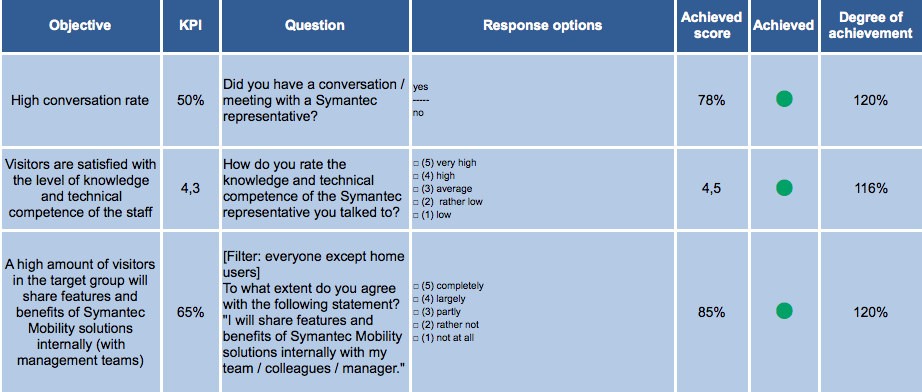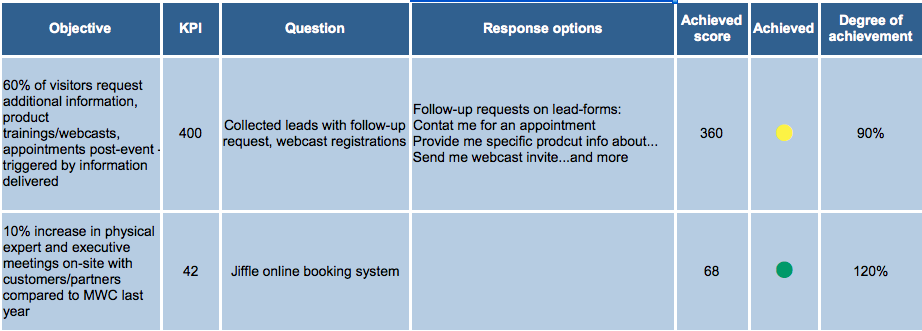Exhibitions at industry trade shows offer companies great opportunities to demonstrate Thought Leadership in their core competencies, to collect leads with a potential business impact, to compare competitive products or to influence positive press coverage. But does this provide enough value for event planners to justify the costs? Learn how to prove the value of meetings and events in this case study from Symantec´s participation at Mobile World Congress 2015.
By Ilka Dzeik, Event ROI Institute and former Head of Events EMEA at Symantec
When Symantec decided to join MWC 2015, one of the most expensive Mobile Industry Trade Shows worldwide, it was one of the management requirements that the net value and contribution to the business objective to increase sales (for Symantec´s Information Protection Solutions for Mobility) was greater than the costs. Obviously there were many ideas from stakeholders how to measure the value from measuring awareness increase to measuring the number of prospect leads turned into business. Most likely the same procedure as used by many organisations to evaluate events.
However we as event owner were seeking for a more systematic approach to prove the value of the exhibition to stakeholders and applied what we had learned about the 6 levels of the Event ROI Methodology. Measurement is a step-by-step process and not as difficult as it may seem. First we defined realistic business impact objectives with all stakeholders such as 10 new leads from the event to become business opportunities with a win probability of >20% within 3 months after the event. This turnaround time was shorter than the normal sales cycle for this solution and therefor an impact of the exhibition.
The next question was “What exactly do we want representatives from each of our targeted visitor categories to do differently after their visit in order to support the business goal?” The visitor may go away from the booth feeling welcomed, impressed and informed, but if they take no action which finally leads to more sales it would not provide any value to the company – the Return on Investment (ROI) is negative. For each category of visitors there were different calls to action. The journalists should publish favorable articles, the prospects should buy software licenses from Symantec, the customers should invest more and upgrade or extend their Symantec product portfolio.
The focus in this case was on new customers and customers with a high cross-sell or upsell potential. Concrete behavior objectives were defined such as 60% of visitors request a follow-up about Symantec´s Information Protection Solutions at the event: visitors ask for sales appointments, more information, attend product trainings and more.
The third level of objectives were the learning objectives “Which information or skills are required, which attitude or relationship should improve so that to the targeted visitors want to meet with sales and invest more in Information Protection Solutions? As a result of internal meetings with the Customers Experience team and sales, we found that potential business hasn´t been closed because customers were uncertain about the complexity, costs, downtime risks and necessary resources to implement Symantec solutions. With this information, the messaging focus for Symantec´s presence at MWC was re-defined to focus on the best solutions to solve the critical customer pain points instead of presenting numerous product features and functions.
Conservative and realistic learning objectives were set such as Visitors score their confidence to explain the requirements to implement Symantec´s Information Protection Solutions with 3.9 out of 5 after a conversation with the booth staff.
Only after all objectives on these 3 levels were clearly defined, the design of the booth and on-site experience was planned. How can we design a learning environment that supports a high engagement level so that at least 50% of all visitors have a physical conversation with the booth staff? Which booth staff do we need so that visitors rate the level of knowledge and technical competence of the booth staff with 4.3 out of 5? How can we design the stand structure so that visitors easily find the information they need?
And last but not least, the target audience objectives where defined such as 55% of visitors in the target group have decision making competence and 25% have new business potential among prospective customers and partners. These categories were invited pre-event to meet the booth staff to discuss their needs and solutions of interest.
The booth staff was briefed and expectations set so that the time spent with visitors who failed to meet the criteria, such as friends and loyal customers, was limited.
Measuring results
We used delegate and booth staff surveys and some smart tools such as Jiffle to find out if we reached the desired target audience and to measure the satisfaction and learning results as well as the change in the behavior of the targeted visitors. To achieve a high response rate and quality data we hired a team of interviewers to collect feedback at the booth, in particular visitors who had a conversation with the booth staff on-site. We used internal databases such as Salesforce.com and sales interviews (self-estimates) to verify the isolated business impacts.
Target Audience Results
Due to the pre-work of carefully inviting customers and pre-scheduled appointments as well as the focus of booth staff on potential customers with decision making competency and high business potential, the results were quite satisfactory, although the business potential target was not met.
Learning Environment Results
Results show that the content, booth staff and booth design was planned successfully towards the desired outcome so that there was a high interaction. Pre-scheduled appointments and pro-active booth staff improved the visitor´s experience. Instead of browsing the booth and hoping to find a free and qualified staff member, the visitors were taken by the hand and guided through their area of interest. The booth staff were highly qualified and felt confident and prepared for the visitor inquiries. Results also indicated that visitors understood the benefits and simplicity of Symantec solutions and would actively share their learning internally. But only the learning results and finally behavior results would prove these assumptions.
Learning Results
The information the visitors received at the booth increased their understanding of the requirements of implementing Symantec´s mobile solutions hence increased their confidence. A good basis to also achieve the desired behavior changes. The increase of knowledge levels could have been measured by asking visitors for their level of knowledge pre-booth visit and after the conversation. Definitely a learning to apply for the next exhibition.
Behavior Results
The follow-up requests increased almost as targeted. And due to an early pre-event involvement of potential visitors and sales the number of scheduled appointments on the booth increased significantly compared to previous years where the engagement started too late.
Business Impact Results
Last but not least the impact results were satisfactory. The number of new leads with concrete business opportunities was slightly less than targeted but the business volume of each lead was excellent and its probability to become a closed deal increased faster than the normal sales cycle, which isolated the impact of the event from other influences.
By tracking those opportunities caused by the exhibition (and nothing else) during the following months, the team was able to calculate the monetary business impact. Finally the team could truly say that the impact values were over-compensating the costs and with an ROI* of 25%, they had the ultimate proof of the event value for all stakeholders.
In summary – not all results were positive and just a few examples are mentioned above. But by planning measurable objectives according to the systematic approach of the ROI Methodology, all stakeholders were clear about the priorities and stayed focused. Also, by measuring the results the team understood the knock-on effect and why some of the objectives had not been reached so that they could work to improve next time. By defining clear and measurable objectives with all stakeholders and measuring them afterwards the effectiveness of Symantec´s exhibition at MWC was much higher than ever before.
(*The profit or loss value as a percentage of the event costs, is the ROI percentage figure. The Return is the sum of Impact values and the Investment is the total cost. Cost of the event also include the opportunity cost of own staff planning and attending the event including the event team or costs of an account manager associated with the time he/she stays away from doing customer visits in his/her territory. In return cost saving of being able to meet with many customers in a short period of time can be offset.)
[purchase_link id=”3679″ text=”Download” style=”button” color=”red”]
Author
Ilka Dzeik, Senior Partner of the Event ROI Institute, joined the institute after 20 years managing international corporate events in the ITC industry. She successfully applied the ROI methodology as Head of Events EMEA at Symantec. Today she shares her knowledge as a trainer, consultant and speaker on event ROI and strategic meeting management.
You may write to her on ilka.dzeik@eventroi.org or visit www.eventroi.org.






